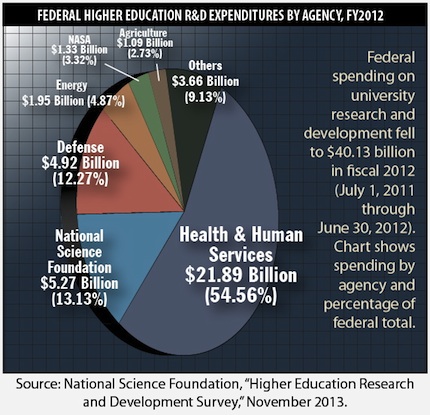Snapshot: Federal Higher Ed R&D Spending by Agency
Federal funding for university research and development has fallen off for the first time since 1974. Two agencies accounted for the decline.
According to the latest Higher Education Research and Development (HERD) Survey from the National Science Foundation, the United States Department of Health and Human Services cut higher ed R&D funding by more than $1.1 billion in fiscal year 2012 (July 1, 2011 through June 30, 2012).
HHS is the single largest source of funding for higher ed R&D, making up nearly one-third (33.29 percent) of the total $65.78 billion invested in higher ed R&D last year counting all sources (federal, state and local governments; businesses; nonprofits; and educational institutions themselves).
HHS higher ed R&D spending in 2012 was about $21.89 billion, a decline of 4.7 percent from 2011's expenditures of $22.98 billion.
NASA also saw a substantial percentage decline in higher ed R&D investment for the second year running, though its contribution is historically much smaller than that of HHS. NASA spent $1.33 billion in 2012, a 6.5 percent decline from the previous year.
Other federal agencies increased their university R&D funding in 2012:
- The National Science Foundation's expenditures grew 2.6 percent to $5.27 billion;
- The Department of Defense grew 2 percent to $4.92 billion;
- The Department of Energy increased expenditures by 4.6 percent, topping $1.95 billion;
- The Department of Agriculture's expenditures grew 8.7 percent, reaching 1.09 billion; and
- All other federal agencies totaled $3.66 billion, an overall increase of 3.9 percent.

Those increases, however, were not enough to compensate for the declines at HHS and NASA. The result was that overall federal spending decreased by 1.6 percent to $40.13 billion. The decline was a slight one but significant for the fact that it was the first decline in federal higher ed R&D spending constant dollars since 1974.
According to NSF: "After adjusting for inflation, higher education R&D declined by 1 percent in FY 2012. This represents the first constant-dollar decline since FY 1974 and ends a period of modest growth in higher education R&D during FYs 2009-11, when R&D expenditures increased an average of 5 percent each year."